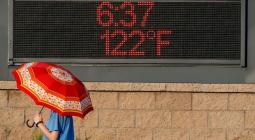What's behind Saudi Arabia's plan to air-condition Riyadh?
Scientists have developed a method to reduce Riyadh's temperature by 4.5°C while saving 16% on cooling energy through heat migration technologies.
It is estimated that around 13,000 cities, which are home to over 1.7 billion people, are facing extremely challenging climatic conditions due to the increasing temperatures. Riyadh, the capital of Saudi Arabia, is known to be one of the hottest cities globally, with temperatures exceeding 50 degrees Celsius during the summer.
This extreme urban heat has affected over 450 cities worldwide, leading to higher energy consumption and negatively impacting people's health, resulting in heat-related illnesses and fatalities.
However, a recent study published in the journal Nature Cities suggests that it is possible to significantly reduce temperatures in cities with hot desert climates like Riyadh, while also reducing energy costs.
The plan to cool Riyadh
The researchers of the study conducted large-scale simulations to reduce temperatures and energy consumption in the cooling process in the Al-Masif neighbourhood in Riyadh.
They developed eight scenarios to mitigate temperatures and determine the optimal strategies to achieve this goal
UNSW Scientia Professor Mattheos Santamouris, Anita Lawrence Chair in High-Performance Architecture and senior author of the study, said, "The project demonstrates the tremendous impact advanced heat mitigation technologies and techniques can have to reduce urban overheating, decrease cooling needs, and improve lives."
The scientists developed a method that allows the city to cool down by approximately 4.5 degrees Celsius in the summer while saving 16% on cooling energy use. Part of the suggested strategy is to use ultra-cold-reflecting materials on building roofs, which are advanced construction materials intended to reflect a high percentage of sunlight and minimise heat absorption.
The strategy also includes using traffic vegetation to improve transpiration cooling, focusing on increasing the ability of outdoor surfaces to reflect sunlight, providing effective external shading devices, and designing windows.
Santamouris told The New Arab, "The city keeps getting hotter because there isn't much greenery, and big artificial surfaces made of traditional building materials like concrete and asphalt trap heat. The temperature of the city is further raised by additional heat from industrial activity and vehicle emissions."
The next generation of Gulf city-planning
Lotfy Azaz, Professor of Urbanism and Geographic Information Systems at Menoufia University, explained to The New Arab that after the discovery of oil in the Arabian Gulf, Western architects and engineers were invited to redesign and plan some Gulf cities again.
However, the engineers and planners brought with them Western models of housing and did not take into account the geographical nature of the place, its privacy, or its urban heritage.
As a result, traditional courtyard houses were replaced by Western-style dwellings that often lacked attention to energy or material efficiency.
But the question is, how did these people live before the arrival of cooling devices?
The answer lies in the building materials imported from the environment, which were made mainly of clay or sand and did not absorb heat as much as concrete blocks used today. The design of houses also differed, as new designs did not take into account traditional ventilation openings or old courtyards.
Sahin Akin, a researcher at the Industrial Environment Program at the Norwegian University of Science and Technology, added that traditional dwellings were more flexible and environmentally friendly, as local materials such as clay and wood were used in their construction.
Therefore, these dwellings were good in terms of environmental performance because the older buildings were designed to cool passively without the aid of air conditioning.
Sahin Akin explained to The New Arab that the Gulf countries have started using more exported materials that cause a lot of greenhouse gas emissions.
They have also begun to use modern materials with high emissions intensity and weak thermal aspects, such as concrete, by replacing locally available wood, clay, and stone. The researcher says that apart from the actual carbon dioxide released from cement manufacturing, concrete has other harms, such as its low environmental performance compared to traditional materials.
"Passive cooling systems have been replaced by high-tech devices, resulting in a lot of energy consumption in terms of cooling requirements. Finally, building design has become larger, resulting in more materials being used for construction and energy to air-condition buildings in return," added Akin.
Professor Mattheos Santamouris suggests that the technologies used in this research can be implemented in all cities across North Africa and the Middle East due to their rapid effectiveness and low cost.
The researchers simulated the energy impact of retrofitting procedures for all 3,323 buildings in the area, along with implementing urban heat mitigation systems.
Based on the proposed heat mitigation plan for Riyadh, the researchers suggested doubling the number of irrigated trees, which could enhance transpiration cooling, and using extremely cold materials on building roofs.
By combining the best cooling technology with energy retrofitting options such as improving windows, insulation, solar power, and cool roofs, the cooling demand could be reduced by up to 35%. Strengthening the building envelope with these options could also help in reducing the cooling demand.
"This represents a significant reduction in Riyadh's energy needs, which would help to reduce the costs associated with cooling the city while improving the quality of life for the local population," concludes Santamouris.
Cover photo: Getty images



